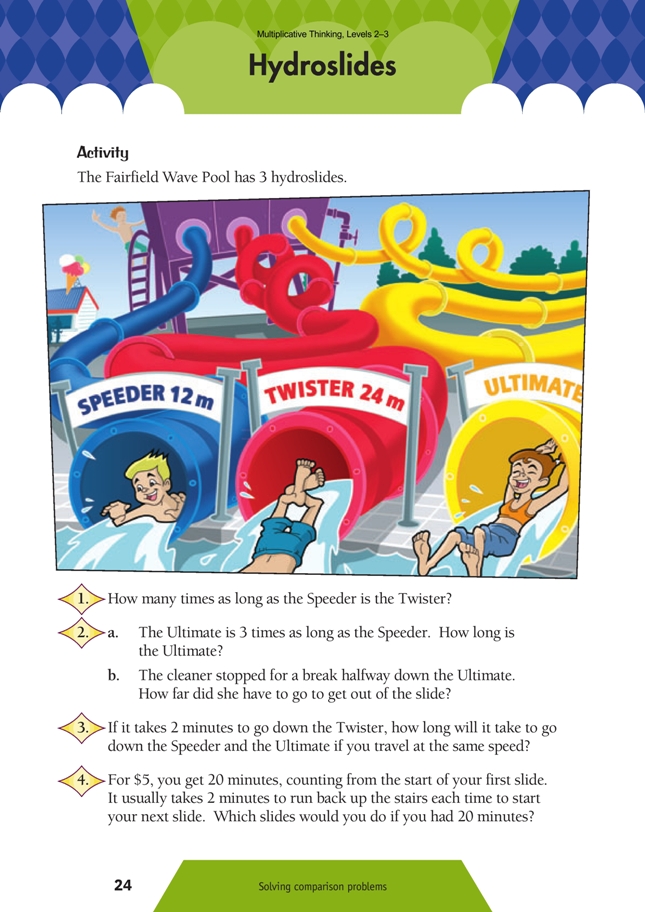This is a level 3 number activity from the Figure It Out series. It relates to Stage 6 of the Number Framework.
A PDF of the student activity is included.
Click on the image to enlarge it. Click again to close. Download PDF (575 KB)
use basic facts to solve problems
use doubles and halves to solve problems
Number Framework Links
The problem structure of this activity will encourage students at stages 4 and 5 to use multiplication rather than addition. It would be a useful independent activity for students at stage 6.
FIO, Levels 2-3, Multiplicative Thinking, Hydroslides, pages 24
This activity asks students to apply their multiplication knowledge to comparison problems. It could be linked with Numeracy Project lessons that seek to get students to apply their number fact knowledge in multiplicative situations.
This activity is another example of multiplicative comparison, like Clever Clues. The first hydroslide is 12 metres long, the second is twice as long, and the third 3 times as long. This is used as a basis to compare other related measurements, such as how long it will take to get down each slide. The activity could be used as an independent activity for students who have already worked on Clever Clues with you as a group to see how they have picked up the concept of “times as many” (multiplicative comparison).
Question 1 asks students to identify the multiplicative relationship between the two slides. Watch for students who say 12 metres. They are seeing the additive relationship, not the multiplicative one.
Questions 2 and 3 further explore the multiplicative relationships and extend them to how long it takes to go down the slide. These numbers are needed to work on question 4.
In question 4, students can explore different ways of using their 20 minutes, using the times found in question 3. The context of the problem means that there are lots of possible solutions and explanations here. Students can present their answers and justifications to the group. They will probably repeat certain slides, so encourage them to use multiplication to express this. For example, 3 turns on the Speeder is 3 minutes (3 x 1), with 3 lots of 2 minutes to get to the top (3 x 2). So 3 turns on the Speeder is 3 + 6 = 9 minutes.
Extend this activity by asking the students to think of other contexts and problems that involve multiplicative comparison. A useful example is Goldilocks and the Three Bears. Mama Bear’s belongings can be 3 times as big as Baby Bear’s, and Papa Bear’s can be 4 times as big (or any other factor). The students can make up measurements and work out the sizes for the other bears’ belongings. For example, Baby Bear’s bowl may hold a cup of porridge, or Mama Bear’s bed may be 3 metres long.
Answers to Activity
1. 2 times as long. ( x 12 = 24 or 24 ÷ 12 = 2)
2. a. 36 m. (3 x 12 = 36 or [3 x 10] + [3 x 2] = 30 + 6 = 36)
b. 18 m. (36 ÷ 2 = 18 or 1/2 of 30 is 15 and 1/2 of 6 is 3: 15 + 3 = 18)
3. Speeder: 1 min; Ultimate: 3 min
4. Answers may vary. If you had 4 Ultimate slides, you would finish 2 min early (starting from the top: 3 + 2 + 3 + 2 + 3 + 2 + 3 = 18 min, with 3 x 4 = 12 min actually sliding). You would also get 12 min on the slides if you had 3 Ultimate
Slides, 1 Twister slide, and 1 Speeder slide: 3 + 2 + 3 + 2 + 3 + 2 + 2 + 2 + 1 = 20 min. (Note that, in real life, you would often do more waiting than sliding!)
